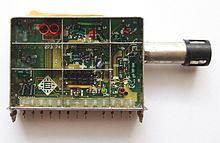| Revision as of 13:08, 13 February 2014 editPol098 (talk | contribs)Extended confirmed users, Pending changes reviewers118,790 editsm →Television← Previous edit | Revision as of 13:09, 13 February 2014 edit undoPol098 (talk | contribs)Extended confirmed users, Pending changes reviewers118,790 editsm →TelevisionNext edit → | ||
| Line 30: | Line 30: | ||
| ==Television== | ==Television== | ||
| A ''television tuner'' converts a ] ] or ] transmission into ] and ] signals which can be further processed to produce ] and a ]. Different tuners are used for different ] such as ], ], ], ], ], ], ], ], ], open cable. An example frequency range is {{nowrap|48.25 MHz - 855.25 MHz}} {{nowrap|(E2-E69)}} |
A ''television tuner'' converts a ] ] or ] transmission into ] and ] signals which can be further processed to produce ] and a ]. Different tuners are used for different ] such as ], ], ], ], ], ], ], ], ], open cable. An example frequency range is {{nowrap|48.25 MHz - 855.25 MHz}} {{nowrap|(E2-E69)}},<!--page 2--><ref name=fm1216/> with a tuning frequency step size of {{nowrap|31.25, 50 or 62.5 kHz.}}<!--page 2--><ref name=fm1216/> Modern solid-state internal TV-tuner modules typically weigh around {{nowrap|45 g.}}<!--page 22--><ref name=fm1216>, 2001-10-18</ref> | ||
| Analog tuners can tune only ]s. An ] is a digital tuner that tunes ]s only. Some digital tuners provide an analog bypass. | Analog tuners can tune only ]s. An ] is a digital tuner that tunes ]s only. Some digital tuners provide an analog bypass. | ||
Revision as of 13:09, 13 February 2014
| This article relies largely or entirely on a single source. Relevant discussion may be found on the talk page. Please help improve this article by introducing citations to additional sources. Find sources: "Tuner" radio – news · newspapers · books · scholar · JSTOR (January 2012) |
| This article needs additional citations for verification. Please help improve this article by adding citations to reliable sources. Unsourced material may be challenged and removed. Find sources: "Tuner" radio – news · newspapers · books · scholar · JSTOR (January 2012) (Learn how and when to remove this message) |

A tuner is a subsystem that receives radio frequency (RF) transmissions like radio broadcasts and converts the selected carrier frequency and its associated bandwidth into a fixed frequency that is suitable for further processing usually because a lower frequency is used on the output. Broadcast FM/AM transmissions are usually fed this intermediate frequency (IF) directly into a demodulator that convert the radio signal into audio-frequency signals that can be fed into an amplifier to drive a loudspeaker. More complex transmissions like PAL/NTSC (TV), DAB (digital radio), DVB-T/DVB-S/DVB-C (digital TV) etc. uses a wider frequency bandwidth. Often with several subcarriers. These are transmitted inside the receiver as an intermediate frequency (IF). The next step is usually either to process subcarriers like real radio transmissions or to sample the whole bandwidth with A/D at a rate faster than the nyquist rate that is at least 2 times the IF frequency.
The term tuner can also refer to a radio receiver or standalone audio component that are part of an audio system, to be connected to a separate amplifier. The verb tuning in radio contexts means adjusting the radio receiver to receive the desired radio signal carrier frequency that a particular radio station uses.
Design

The simplest tuner consists of an inductor and capacitor connected in parallel, where the capacitor or inductor is made to be variable. This creates a resonant circuit which responds to an alternating current at one frequency. Combined with a detector, also known as a demodulator, (diode D-1, in the circuit), it becomes the simplest radio receiver, often called a crystal set.
Practical radio tuners use a superheterodyne receiver. Older models would realize manual tuning by means of mechanically operated ganged variable capacitors. Often several sections would be provided on a tuning capacitor, to tune several stages of the receiver in tandem, or to allow switching between different frequency bands. A later method used a potentiometer supplying a variable voltage to varactor diodes in the local oscillator and tank circuits of front end tuner, for electronic tuning. Still later, phase locked loop methods were used, with microprocessor control.
In a self-contained radio receiver for audio, the signal from the detector after the tuner is run through a volume control and to an amplifier stage. The amplifier feeds either an internal speaker or headphones. In a tuner component of an audio system (for example, a home high-fidelity system or a public address system in a building), the output of the detector is connected to a separate external system of amplifiers and speakers.
The broadcast audio FM band (88 - 108 MHz in most countries) is around 100 times higher in frequency than the AM band and provides enough space for a bandwidth of 50 kHz. This bandwidth is sufficient to transmit both stereo channels with almost the full bandwidth of the human ear. Sometimes, additional subcarriers are used for unrelated audio or data transmissions. The left and right audio signals must be combined into a single signal which is applied to the modulation input of the transmitter; this is done by the addition of an inaudible subcarrier signal to the FM broadcast signal. FM stereo allows left and right channels to be transmitted. The availability of FM stereo, a quieter VHF broadcast band, and better fidelity lead to the specialization of FM broadcasting in music, tending to leave AM broadcasting with spoken-word material.
Restoration
Standalone audio stereo FM tuners are sought after for audiophile and TV/FM DX applications, especially those produced in the 1970s and early 1980s, when performance and manufacturing standards were among the highest. In many instances the tuner may be modified to improve performance. A growing hobby trend is the electronics specialists that buy, collect and restore these vintage FM or AM/FM audio tuners. The restoration usually begins with replacing the electrolytics (capacitors) that age over time. The tuner is outfitted with improved tolerance and better sounding upgraded parts. Prices have increased relative to the increasing demand for the older audio tuners. Those with the most value are the best sounding, most rare (collectible), the best DX capable (Distance Reception) and the known build quality of the component, as it left the factory.
AM/FM
Most of the top end audio tuner models were designed and manufactured to receive only the AM broadcast band. As FM became more popular, the limitations of AM became more apparent, and FM became the primary listening focus, especially for stereo and music broadcasting. The bulk of tuners made for the market, however, were AM/FM design, especially in the 1980s and 1990s. Few companies even manufacture dedicated FM or AM/FM tuners now, as these bands are most often included in a low cost chip for A/V systems, more as an afterthought, rather than designed for the critical FM listener. The FM aficionado must really look to the classic tuner models and either rebuild or upgrade the unit to satisfy demanding FM listeners. A few 1970s tuners feature now-deprecated Dolby noise reduction for FM broadcasts.
In Europe, where a second AM broadcast band is used for longwave broadcasting, tuners may be fitted with both the standard medium wave and the additional longwave band. However, radios with only medium wave are also common, especially in countries where there are no longwave broadcasters. Rarely, radios are sold with only FM and longwave, but no medium wave band.
Television
A television tuner converts a radio frequency analog television or digital television transmission into audio and video signals which can be further processed to produce sound and a picture. Different tuners are used for different television standards such as PAL, NTSC, ATSC, SECAM, DVB-C, DVB-T, DVB-T2, ISDB, T-DMB, open cable. An example frequency range is 48.25 MHz - 855.25 MHz (E2-E69), with a tuning frequency step size of 31.25, 50 or 62.5 kHz. Modern solid-state internal TV-tuner modules typically weigh around 45 g.
Analog tuners can tune only analog signals. An ATSC tuner is a digital tuner that tunes digital signals only. Some digital tuners provide an analog bypass.
VHF/UHF TV tuners are rarely found as a separate component, but are incorporated into television sets. Cable boxes and other set top boxes contain tuners for digital TV services, and send their output via SCART or other connector, or using an RF modulator (typically on channel 36 in Europe and channel 3/4 in North America) to TV receivers that do not natively support the services. They provide outputs via composite, S-video, or component video. Many can be used with video monitors that do not have a TV tuner or direct video input. They are often part of a VCR or digital video recorder (DVR, PVR). Many home computers in the 1970s and 1980s used an RF modulator to connect to a TV set.
Personal computers may be fitted with expansion cards (typically with PCI or USB interface) providing a TV tuner and digital signal processor (DSP). They may be dedicated TV tuner cards, or incorporated into a video card. These cards allow a computer to display and capture television programs. Many earlier models were stand-alone tuners, designed only to deliver TV pictures through a VGA connector; this allowed viewing television on a computer display, but did not support recording television programs.
Electronic Tuner
An electronic tuner is a device which tunes across a part of the radio frequency spectrum by the application of a voltage or appropriate digital code words. This type of tuner supersedes mechanical tuners, which were tuned by manual adjustment of capacitance or inductance in the tuned circuits. In a more practical and everyday sense, a radio or television set which is tuned by manually turning a knob or dial contains a manual tuner into which the shaft of that knob or dial extends.
Later model televisions and radios were tuned by a rack of momentary push buttons; some of the earlier types were purely mechanical and adjusted the capacitance or inductance of the tuned circuit to a preset number of positions corresponding to the frequencies of popular local stations. Later electronic types utilized the varactor diode as a voltage controlled capacitance in the tuned circuit, to receive a number of preset voltages from the rack of buttons tuning the device instantly to local stations. The mechanical button rack was popular in car radios of the 1960s and 1970s. The electronic button rack controlling the new electronic varactor tuner was popular in television sets of the 1970s and 1980s.
Modern electronic tuners also use varactor diodes as the actual tuning elements, but the voltages which change their capacitance are obtained from a digital to analog converter (DAC) driven by a microprocessor or phase locked loop (PLL) arrangement. This modern form allows for very precise tuning and locking-in on weak signals, as well as a numerical display of the tuned frequency.
See also
- Analog passthrough
- ATSC tuner
- Cable converter box
- Digital television adapter (DTA)
- Minimum detectable signal
- QAM tuner
- Radio antenna
- Receiver (radio)
- Set top box
- Television antenna
- Television set
- TV tuner card
References
- amfmdx.net - FM Tuner Mods
- ^ ivtvdriver.org - FM1216ME (MK3 family). Multi-Standard Desktop Video & FM, Radio Module, 2001-10-18